Butter Chicken
This post may contain affiliate links. Read my full disclosure policy.
This easy butter chicken recipe features ultra-tender chicken simmered in a rich, creamy, spice-infused tomato sauce.
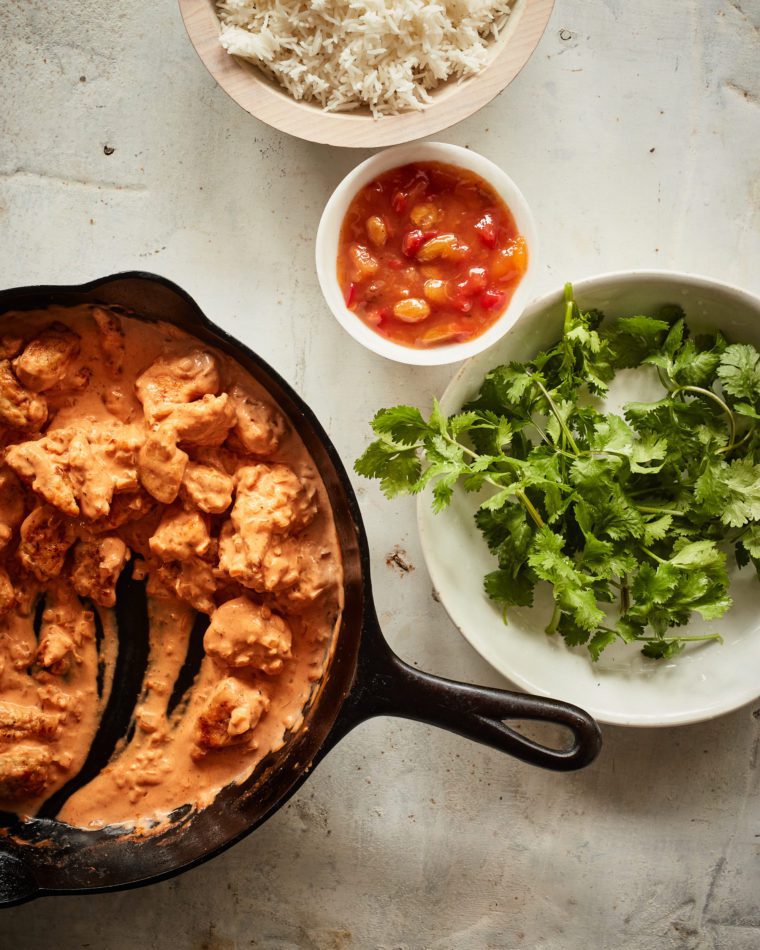
Photo by Johnny Miller (Clarkson Potter, 2021)
A staple menu item in many Indian restaurants in the U.S., butter chicken, also known as Murgh Makhani, was supposedly created when a restaurateur in India combined leftover chicken with a tomato sauce enriched with butter and cream. Traditionally, the chicken for this dish is marinated in yogurt, lemon, and spices and then cooked in a clay oven called a tandoor.
To save time and make the dish home cook-friendly, I sauté unmarinated, seasoned chicken in a skillet and then briefly simmer it in a creamy, spice-infused tomato sauce. This results in ultra-tender chicken. In fact, one reader remarked that this must be called “butter chicken” because the chicken is so tender, it’s like “buttah!” Along with basmati rice or naan, I love a little mango chutney on the side; it adds a delicious gingery sweetness that complements the chicken.
Table of Contents
“If I could give you ten stars for this recipe, I would…As good as any take-out Indian food I have ever eaten. A definite winner!”
What You’ll Need To Make Butter Chicken
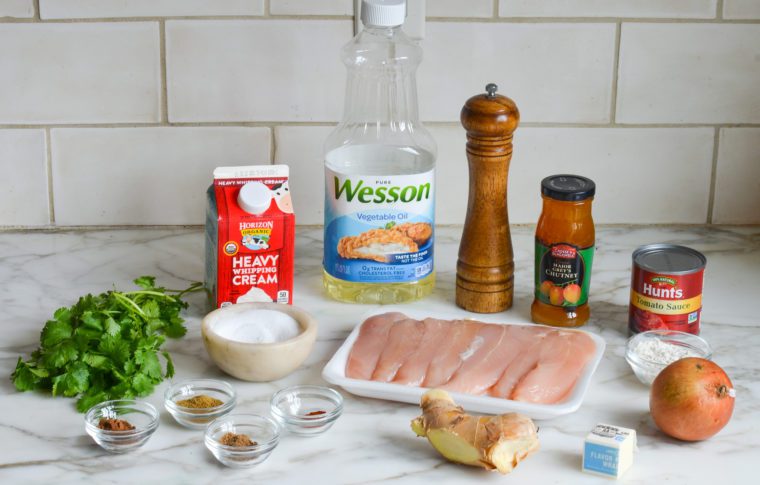
- Chicken Tenderloins: Tenderloins are lean, ultra-tender, and cook quickly, making them a great choice. Boneless skinless breasts may be substituted.
- All-Purpose Flour: Used to lightly coat the chicken before cooking. This not only helps to give the chicken a flavorful crust when browned but also aids in thickening the sauce once the chicken is added back to the pan with the other ingredients.
- Onion and Ginger: These aromatics form the flavor base of the dish.
- Garam Masala, Coriander, Cumin, and Cayenne Pepper: This blend of spices is crucial for achieving the authentic, richly layered flavor profile of butter chicken.
- Canned Tomato Sauce: Acts as the base for the sauce, offering a tangy sweetness that balances the richness of the cream and the complexity of the spices.
- Heavy Cream: Adds richness and creaminess to the sauce.
- Cilantro: Brightens up the dish with color and herbal freshness.
- Jump to the printable recipe for precise measurements
Step-by-Step Instructions
In a medium bowl, sprinkle the chicken pieces evenly with 3/4 teaspoon of the salt and 1 teaspoon of the garam masala; toss to coat evenly.
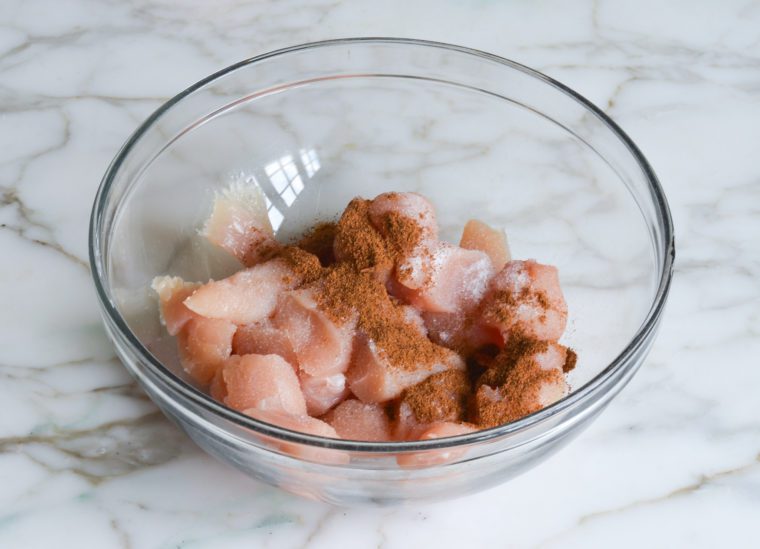
Add the flour.
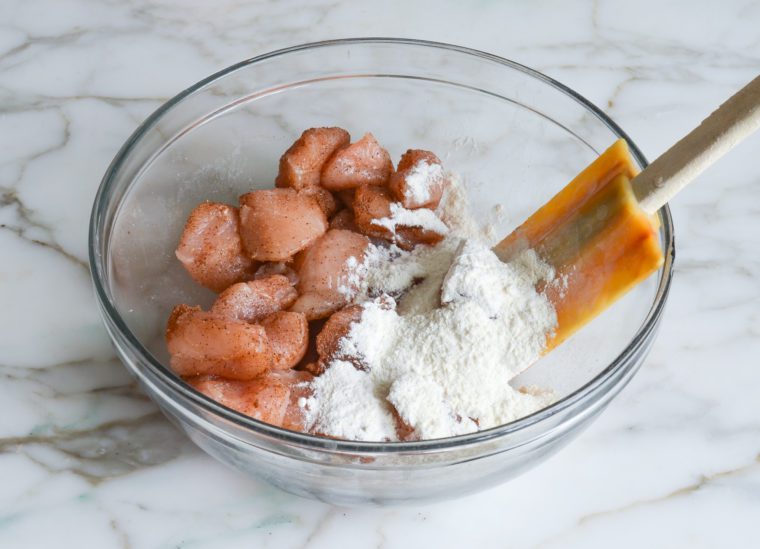
Toss again, making sure the chicken is well coated.
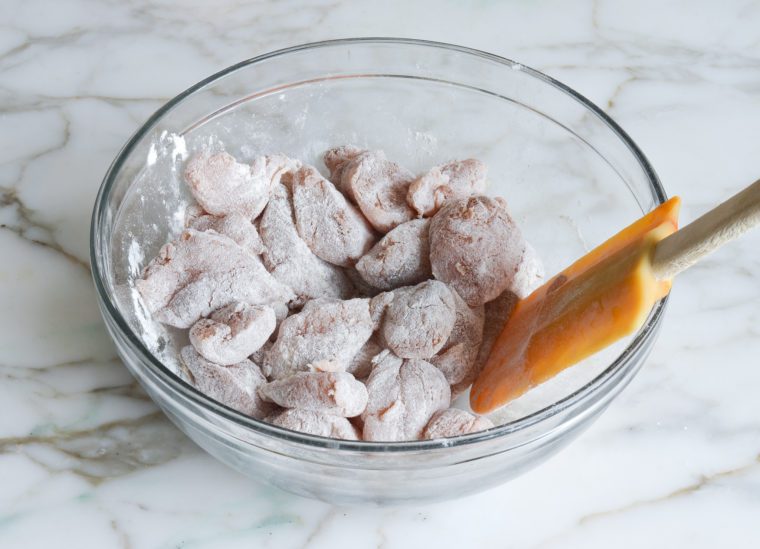
In a large nonstick skillet, heat 1 tablespoon of the butter and the oil over medium-high heat. When the fat is hot and shimmering, add the chicken in a single layer and cook, without stirring, until the chicken is lightly golden on the underside, about 3 minutes.
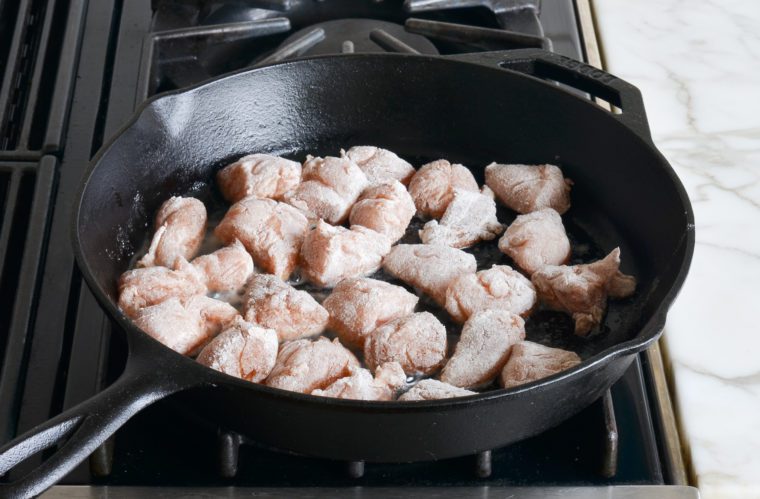
Using tongs, turn the chicken pieces over and cook until just cooked through, 2 to 3 minutes more. Using the tongs, transfer the chicken to a plate and set aside while you make the sauce (you’ll use the skillet in the next step—there’s no need to wash it).
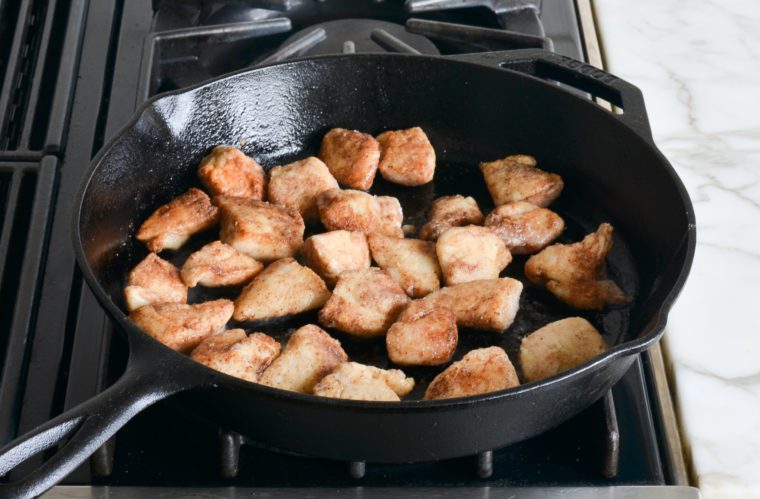
Melt the remaining tablespoon butter in the same skillet over medium heat. Add the onion and ginger and cook, stirring frequently, until softened, 3 to 4 minutes.
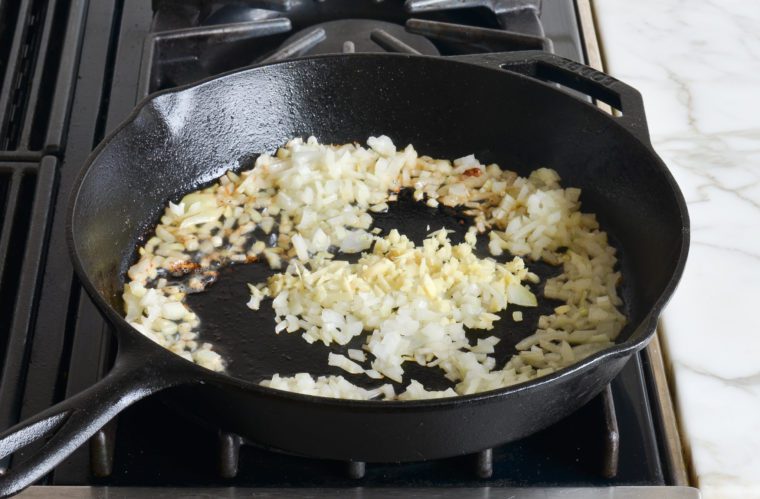
Add the coriander, cumin, cayenne (if using), and remaining teaspoon of garam masala; stir and cook 1 minute more.
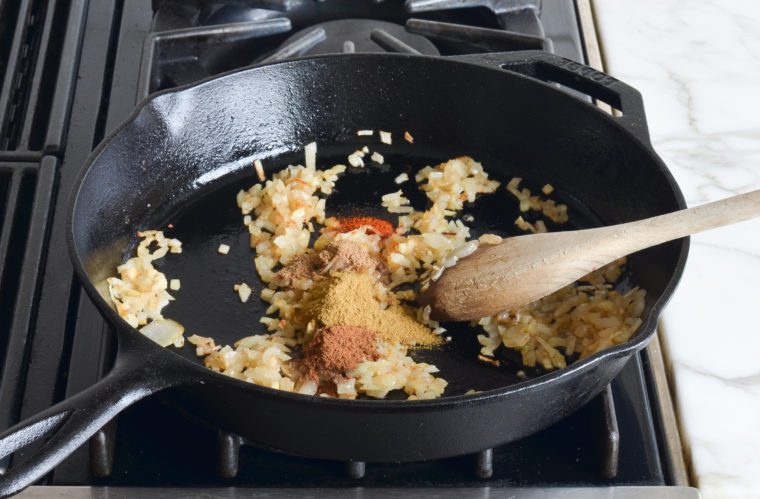
Add the tomato sauce, cream, sugar, pepper, water, and the remaining 1/2 teaspoon salt. Bring to a gentle boil, then reduce the heat and simmer, uncovered, until slightly thickened, about 3 minutes.
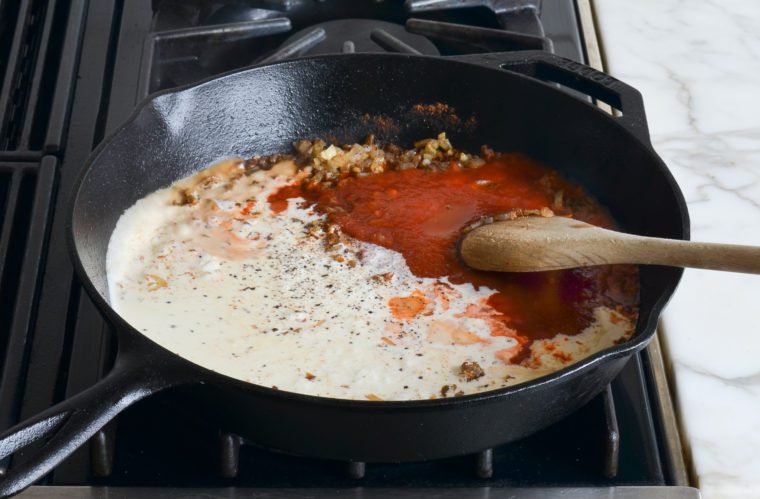
Add the chicken along with any accumulated juices, to the sauce.
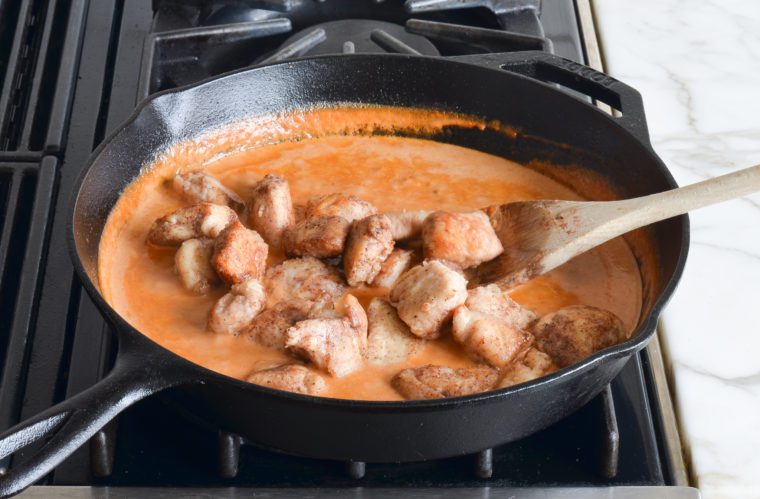
Simmer a few minutes, until the chicken is warmed through.
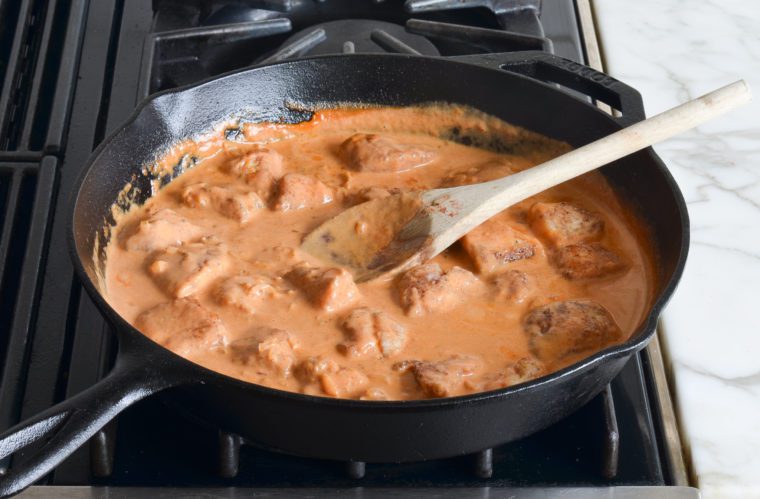
Taste the sauce and adjust the seasoning if necessary. Sprinkle with the cilantro, if using.
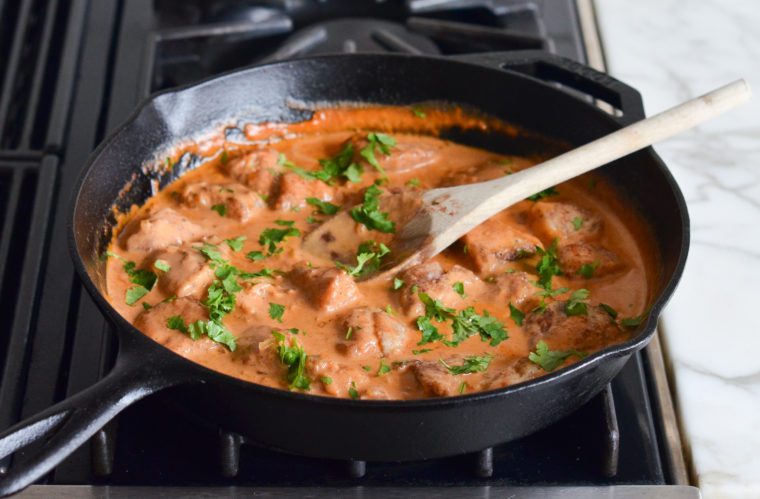
Frequently Asked Questions
Chicken tenderloins are the perfect choice for this dish due to their exceptional tenderness and rapid cooking time. While boneless, skinless chicken breasts are also a good option, they tend to be less forgiving and may become dry if overcooked.
Typically, chicken tenderloins come with a white tendon attached, which can be somewhat tough to chew. To improve the texture, I recommend removing this tendon prior to cooking. Using kitchen shears, simply grasp the tip of the tendon with your fingers and cut it where it connects to the meat. This quick step ensures every bite of chicken is perfectly tender and enjoyable.
Yes, simply prepare the dish as instructed, allow it to cool, and then store it in an airtight container in the refrigerator for 3 to 4 days. Reheat gently on the stove over low heat, adding a little water if the sauce has thickened too much during storage.
Butter chicken is traditionally cooked with ghee, a type of clarified and fermented Indian butter that has a higher smoke point than plain butter. Since I don’t have ghee on hand in my kitchen and butter burns over high heat, I use a combination of butter and oil to get a similar effect; oil raises the smoke point of the fat and prevents the milk solids in the butter from burning.

Video Tutorial
You May Also Like
Butter Chicken
This easy butter chicken recipe features ultra-tender chicken simmered in a rich, creamy, spice-infused tomato sauce.
Ingredients
- 1½ lbs chicken tenderloins, tendons trimmed, or boneless skinless breasts, cut into 1½-inch pieces (see note)
- 1¼ teaspoons salt
- 2 teaspoons garam masala
- 3 tablespoons all-purpose flour
- 2 tablespoons unsalted butter
- 1 tablespoon vegetable oil
- 1 medium yellow onion, finely chopped (about 1 cup)
- 1½ tablespoons finely chopped fresh ginger (from a 2-inch knob) (see note)
- 1 teaspoon ground coriander
- 1¾ teaspoons ground cumin
- ⅛ teaspoon cayenne pepper (optional)
- 1 (8-ounce) can tomato sauce
- 1 cup heavy cream
- ¾ teaspoon sugar
- ¼ teaspoon freshly ground black pepper
- 3 tablespoons water
- 3 tablespoons chopped fresh cilantro (optional)
For Serving (optional)
- Basmati rice
- Mango chutney (such as Major Grey's)
Instructions
- Pat the chicken dry with a paper towel. In a medium bowl, sprinkle the chicken pieces evenly with ¾ teaspoon of the salt and 1 teaspoon of the garam masala; toss to coat evenly. Add the flour and toss again, making sure the chicken is well coated.
- In a large (12-inch) nonstick skillet, heat 1 tablespoon of the butter and the oil over medium-high heat. When the fat is hot and shimmering, add the chicken in a single layer and cook, without stirring, until the chicken is lightly golden on the underside, about 3 minutes. Using tongs, turn the chicken pieces over and cook until just cooked through, 2 to 3 minutes more. Transfer the chicken to a plate and set aside while you make the sauce (you’ll use the skillet in the next step—there’s no need to wash it).
- Melt the remaining tablespoon butter in the same skillet over medium heat. Add the onion and ginger and cook, stirring frequently, until softened, 3 to 4 minutes. If the onion starts to brown, reduce the heat. Add the coriander, cumin, cayenne (if using), and remaining teaspoon of garam masala; stir and cook 1 minute more. Add the tomato sauce, cream, sugar, pepper, water, and the remaining ½ teaspoon salt. Bring to a gentle boil, then reduce the heat and simmer, uncovered, until slightly thickened, about 3 minutes.
- Add the chicken, along with any accumulated juices, to the sauce and simmer just a few minutes until the chicken is warmed through. Taste the sauce and adjust the seasoning if necessary. Sprinkle with the cilantro, if using, and serve with basmati rice and mango chutney. (Note that the sauce will thicken as it sits; thin with a bit of water if necessary.)
- Note: Chicken tenderloins are ideal for this dish as they are ultra-tender and cook quick quickly. Boneless, skinless breasts work well too, but they are less forgiving and can become dry if overcooked. The tenderloins typically have a white tendon attached to them. They can be a little tough to chew, so I like to remove them with kitchen shears before cooking. Just pinch the tip of the tendon with your finger and snip where the tendon meets the chicken.
- Note: This dish is traditionally cooked with ghee, a type of clarified and fermented Indian butter that has a higher smoke point than plain butter. Since I don’t have ghee on hand in my kitchen and butter burns over high heat, I use a combination of butter and oil to get a similar effect (oil raises the smoke point of the fat and prevents the milk solids in the butter from burning).
- Make-Ahead Instructions: Prepare the dish as instructed, allow it to cool, and then store it in an airtight container in the refrigerator for 3 to 4 days. Reheat gently on the stove over low heat, adding a little water if the sauce has thickened too much during storage.
Pair with
Nutrition Information
Powered by ![]()
- Per serving (4 servings)
- Calories: 793
- Fat: 59 g
- Saturated fat: 23 g
- Carbohydrates: 40 g
- Sugar: 6 g
- Fiber: 4 g
- Protein: 28 g
- Sodium: 1,063 mg
- Cholesterol: 167 mg
This website is written and produced for informational purposes only. I am not a certified nutritionist and the nutritional data on this site has not been evaluated or approved by a nutritionist or the Food and Drug Administration. Nutritional information is offered as a courtesy and should not be construed as a guarantee. The data is calculated through an online nutritional calculator, Edamam.com. Although I do my best to provide accurate nutritional information, these figures should be considered estimates only. Varying factors such as product types or brands purchased, natural fluctuations in fresh produce, and the way ingredients are processed change the effective nutritional information in any given recipe. Furthermore, different online calculators provide different results depending on their own nutrition fact sources and algorithms. To obtain the most accurate nutritional information in a given recipe, you should calculate the nutritional information with the actual ingredients used in your recipe, using your preferred nutrition calculator.

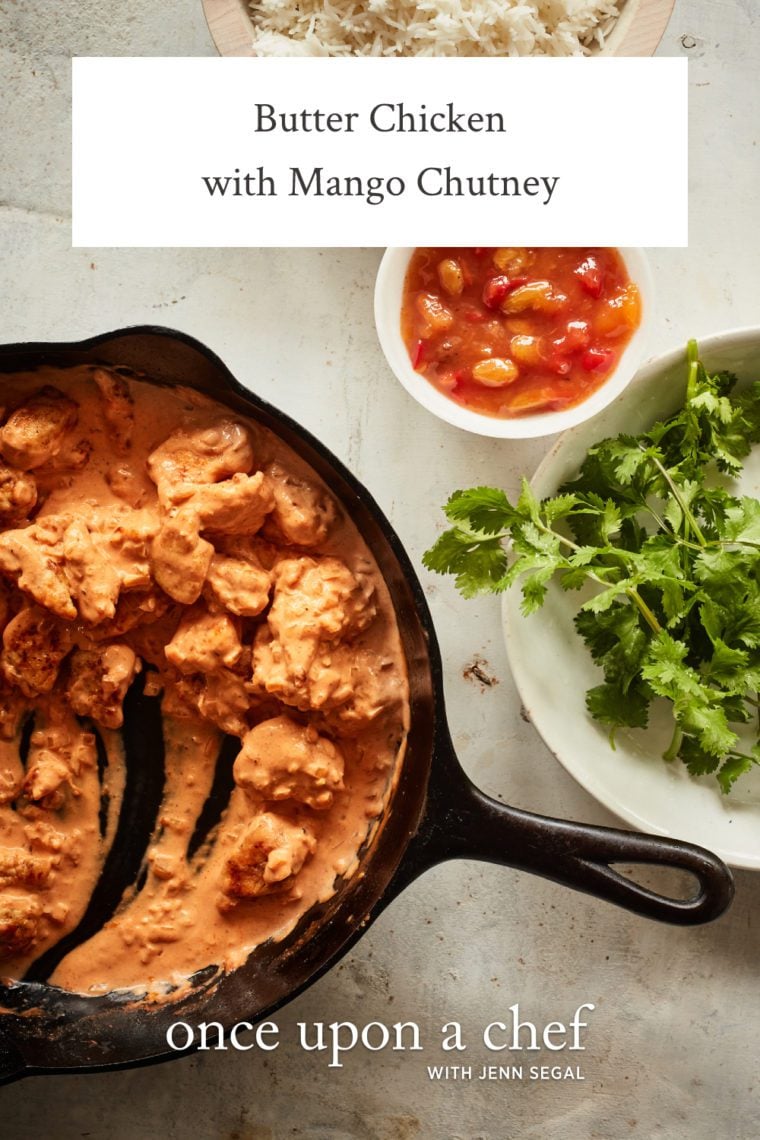
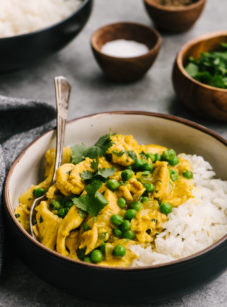
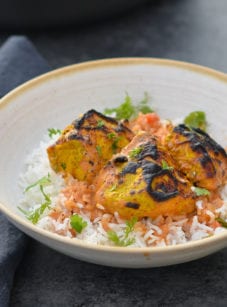
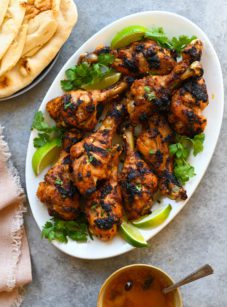
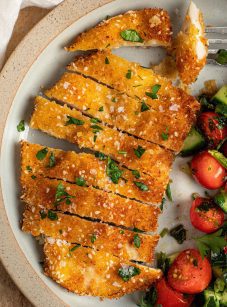
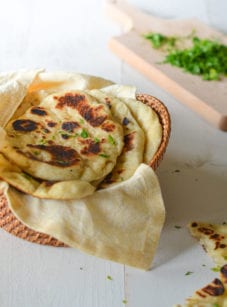
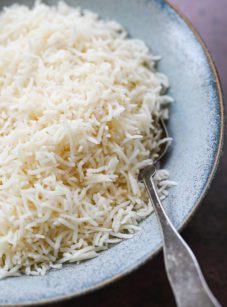
Any chance I could use something other than the heavy cream? Half & half even?
Thanks!
Sure, I think you could get away with 1/2 and 1/2. Please LMK how it turns out if you try it!
I made the recipe last night with 1/2 and 1/2 instead of cream–turned out just wonderfully!
On another note, the recipe doesn’t say to peel the ginger but I did–assumed you should. Was I wrong?
Thanks Jen–great recipes as always!
So glad you enjoyed it, Kathryn! And yes, it’s correct to peel the ginger.
Hi Jenn. I’m looking forward to trying this but wanted to ask if this will work in a cast iron skillet or a large regular all-clad aluminum skillet – I don’t have a nonstick skillet. Thanks again for all your amazing recipes, you’ve made me a better cook and a more confident one!
Cast iron will work well. Enjoy 🙂
A friend had given me her recipe for butter chicken which I was going to make tonight….but then I remember seeing it in your latest cookbook so I made yours tonight for dinner. SO TOTALLY AMAZING…spices were right on..WE LOVED IT!! Thank you for another GREAT recipe!
I love butter chicken. Have tried a few different recipes. I look forward to trying this one!
Hi Jenn,
I usually love your recipes, and have made some of the dishes based on the recipe you have posted, and they were great. Unfortunately this time, being an Indian and having followed some of the very acclaimed chefs from India, I would have to disagree with your Americanized Butter Chicken recipe. It might be good but just reading over your recipe, I can assure you that this can never be called by any stretch of imagination a butter chicken. The basic essence in a classic butter chicken is the spice mix and the chicken marination. And Flour coating on chicken in a butter chicken??? Good lord.
Instead of Butter Chicken you might want to call it Quick and Easy Chicken in a Tomato Sauce.
I still love all your posts and recipes and would earnestly request you to keep it alive with well time tested recipes and not venture into time tested recipes.
All the best for your future posts.
Debasish – I am Desi too. However, she does state that traditionally this recipe is made using marination in spices etc. She is giving a more short cut version of it.
The side of mango chutney -now that I have to admit I have never heard of or seen eaten as a complement to butter chicken, but to each their own!
It is refreshing to see people try to adapt other cultures’ cuisines into their own lifestyle, even if it is not entirely authentic. It doesn’t have to be. It helps to increase awareness and acceptance.
Love your recipes Jen!
I have to be honest, this was SO good. I was scared at first because I’m not a fan of some of the spices but the way it blended was OUTSTANDING. we wiped the pot clean. Will be making again for sure. I’ve never ever made a recipe from you that wasn’t 10/10.
I have made this recipe (new cookbook is full of great recipes like this one!). I would put this up there in Jenn’s top 10 (maybe top 5) – the best part of the recipe (besides the taste which is divine) is that it is easy to make! Limited ingredients, prep time and cook time. Loved it.
Hi Jenn! Can’t wait to try your version of butter chicken. Quick question: I know many garam masala spice blends include salt. Does yours? Just want to check so I know whether to add the additional salt called for in the recipe or skip it. Normally, I would just wait to the end to adjust the salt, but since the seasoning is added right at the get-go I thought I’d check.
Hi Noreen, Mine does not include salt. Hope you enjoy!
I just made this last night – it was amazing!! I didn’t have the chutney but it was still delicious! We had garlic naan to round out the meal. I have never been disappointed by any of your recipes!
Good morning.
May i ask could u use cornstarch to velvet the chicken ?
Thanks,
Sure – enjoy!
Can coconut milk be substituted for cream?
This looks grest!
Sure, I think that should work. Please LMK how it turns out with coconut milk!